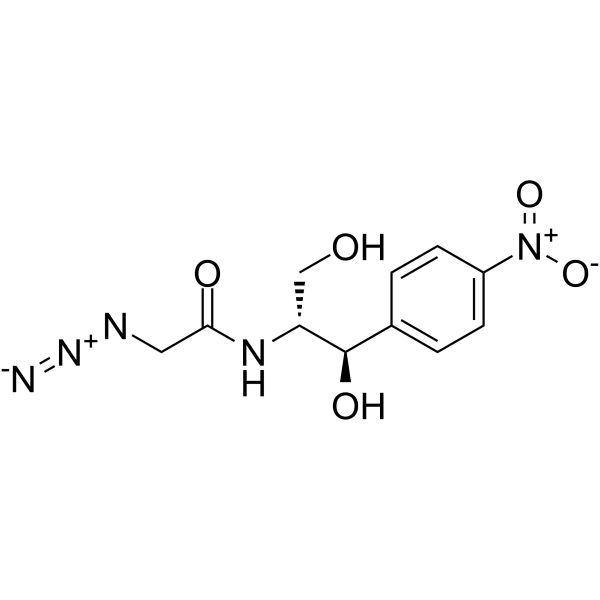
Azidamfenicol
CAS No. 13838-08-9
Azidamfenicol( —— )
Catalog No. M26622 CAS No. 13838-08-9
Azidamfenicol inhibits ribosomal peptidyltransferase with a Ki of 22 μM. Azidamfenicol is a broad-spectrum chloramphenicol-like antibiotic.
Purity : >98% (HPLC)
 COA
COA
 Datasheet
Datasheet
 HNMR
HNMR
 HPLC
HPLC
 MSDS
MSDS
 Handing Instructions
Handing Instructions
| Size | Price / USD | Stock | Quantity |
| 2MG | 86 | Get Quote |


|
| 5MG | 123 | Get Quote |


|
| 10MG | 204 | Get Quote |


|
| 25MG | 375 | Get Quote |


|
| 50MG | 557 | Get Quote |


|
| 100MG | 791 | Get Quote |


|
| 200MG | Get Quote | Get Quote |


|
| 500MG | Get Quote | Get Quote |


|
| 1G | Get Quote | Get Quote |


|
Biological Information
-
Product NameAzidamfenicol
-
NoteResearch use only, not for human use.
-
Brief DescriptionAzidamfenicol inhibits ribosomal peptidyltransferase with a Ki of 22 μM. Azidamfenicol is a broad-spectrum chloramphenicol-like antibiotic.
-
DescriptionAzidamfenicol inhibits ribosomal peptidyltransferase with a Ki of 22 μM. Azidamfenicol is a broad-spectrum chloramphenicol-like antibiotic.
-
In Vitro——
-
In Vivo——
-
Synonyms——
-
PathwayGPCR/G Protein
-
TargetAntibacterial
-
Recptorsialyltransferase
-
Research Area——
-
Indication——
Chemical Information
-
CAS Number13838-08-9
-
Formula Weight295.25
-
Molecular FormulaC11H13N5O5
-
Purity>98% (HPLC)
-
Solubility——
-
SMILESO=C(N[C@H](CO)[C@H](O)C1=CC=C([N+]([O-])=O)C=C1)CN=[N+]=[N-]
-
Chemical Name——
Shipping & Storage Information
-
Storage(-20℃)
-
ShippingWith Ice Pack
-
Stability≥ 2 years
Reference
1.Gupta R, et al. Serine hydroxymethyl transferase 1 stimulates pro-oncogenic cytokine expression through sialic acid to promote ovarian cancer tumor growth and progression. Oncogene. 2017 Jul 13;36(28):4014-4024.
molnova catalog



related products
-
F7H
F7H is a potent Frizzled receptor FZD7 antagonist with an IC50 value of 1.25 μM.F7H is a potent ligand for the transmembrane structural domain (TMD) of FZD7, with potential antitumor and bacteriostatic activity.
-
MONOCAPRYLIN
Monocaprylin is a monoglyceride of caprylic acid with an excellent?antibacterial?activity. Monocaprylin inhibits a variety of foodborne pathogenic and spoilage microorganisms and has the potential for an alternative food preservative research.
-
Cefcapene Pivoxil Hy...
Cefcapene Pivoxil is the pivalate ester prodrug form of cefcapene a semi-synthetic third-generation cephalosporin with antibacterial activity.



 Cart
Cart
 sales@molnova.com
sales@molnova.com


